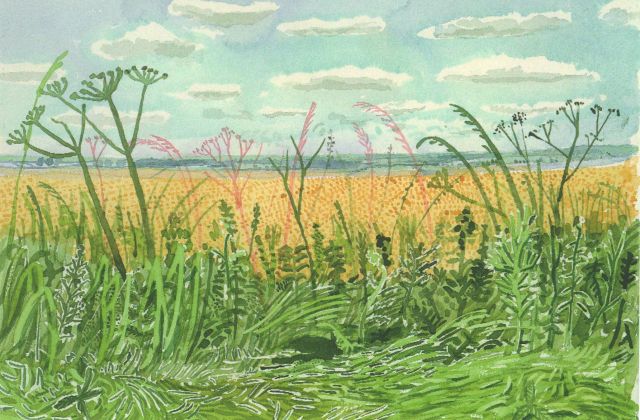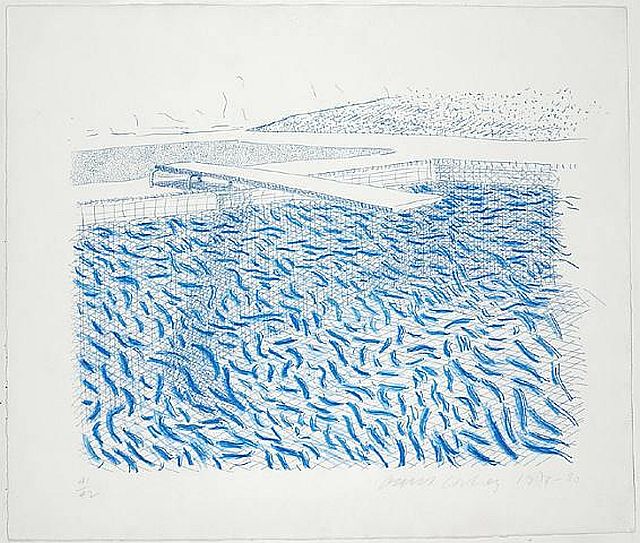Three days in the Yorkshire Dales being blown and buffeted by the tail winds of Hurricane Katia. On our first evening, in our friends’ caravan in Littondale, there was a power cut for a couple of hours as the wind roared and shook us.
The woods crashing through darkness, the booming hills,
Winds stampeding the fields under the window
Floundering black astride and blinding wet Till day rose; then under an orange sky
The hills had new places, and wind wielded
Blade-light, luminous black and emerald,
Flexing like the lens of a mad eye. At noon I scaled along the house-side as far as
The coal-house door. Once I looked up –
Through the brunt wind that dented the balls of my eyes
The tent of the hills drummed and strained its guyrope, The fields quivering, the skyline a grimace,
At any second to bang and vanish with a flap;
The wind flung a magpie away and a black-
Back gull bent like an iron bar slowly. The house Rang like some fine green goblet in the note
That any second would shatter it. Now deep
In chairs, in front of the great fire, we grip
Our hearts and cannot entertain book, thought, Or each other. We watch the fire blazing,
And feel the roots of the house move, but sit on,
Seeing the window tremble to come in,
Hearing the stones cry out under the horizons.
– ‘Wind’ by Ted Hughes
The next evening I still struggled to stand upright and hold the camera steady to take this photo at the highest point in Coverdale on Tuesday evening.
By yesterday, though, the weather was warmer and calmer for a visit to Salt’s Mill at Saltaire, where a new exhibition of works by David Hockney has just opened.
25 Trees and Other Pictures features as its centrepiece a triptych with the classic Hockney title of 25 Trees Between Bridlington School and Morrison’s Supermarket along Bessingby Road in the Semi-Egyptian Style. It consists of the same scene photographed in summer, autumn and winter, each image nearly 30 feet in length.

The triptych is being exhibited for the first time at Salts Mill, alongside a large selection of Hockney’s work of all kinds from all stages of his career, including portraits of family and friends, recent Yorkshire landscapes and projections of his latest iPhone and iPad art.
Since settling in Bridlington some five years ago, Hockney has taken to documenting the landscape of his native Yorkshire in the same vibrant colours which he has utilized to paint California in the past. A selection of these Yorkshire landscapes – oils, watercolours and iPad creations – are on display. Hockney has a major exhibition opening at the Royal Academy in 2012, but thanks to Salt’s Mill us Northerners get a chance to see some of this work before the capital does.

Which is only right and proper, since Hockney has given his support to this place ever since it was bought by his friend Jonathan Silver in 1987. Like Hockney, Silver attended Bradford Grammar (though many years later). Aged 13 and editing the school magazine, Silver brashly invited Hockney to contribute a cover image. The two remained in touch over the years, and when Silver bought the mill, named after Sir Titus Salt who built it in 1853, Hockney enthusiastically agreed to contribute pictures for the gallery. The collection has grown from 56 paintings in 1987 to over 400 pieces, the largest holding of Hockney’s works in the world.
One of the works on display is Sunflowers for Jonathan (above), painted for Silver as he lay dying of cancer in 1997 aged only 47. Jonathan’s daughter Zoe now runs the mill and curates the exhibitions. Commenting on the 25 Trees triptych, Zoe Silver said:
The trio of pictures is being exhibited for the first time at Salt’s. They relate to David’s recent rural images – some of which are also on show – but these lengthy works show a love of the more urban environment, and the transformative power of seasonal change.
Typical of the recent Yorkshire images is the vibrant oil, The Road Across the Wolds (below), displayed along with some of the superb watercolours and tree paintings that he has produced in Yorkshire recently.

Coincidentally, Hockney’s massive ‘Bigger Trees Near Warter‘ has been wending its way around Yorkshire (it’s currently on show in Hull, before moving to Leeds). Hockney gifted the work, the largest he has ever painted, to the Tate in 2008. It was executed on fifty canvas panels and measures 15 by 40 feet. Trees dominate Hockney’s recent work: ‘like people, trees are all individuals’, he says. ‘In the winter, you’ll notice their differences more than in the summer, because the branches are all pointing up, looking for light. And a tree like that, especially in winter, is the best physical manifestation we see of the life force.’

The Yorkshire watercolours are superb, revealing Hockney’s absolute mastery of the medium. From March 2002 through to early 2005 Hockney concentrated almost exclusively on watercolour, a medium with which he had previously only briefly experimented. Well aware that watercolour painting had fallen into disrepute – disparaged as the medium of choice for the amateur artist and Sunday painter – Hockney set out to reassert its artistic credibility. Midsummer: East Yorkshire 2004 is a series of 36 watercolours that he painted in this period; some of them can be seen at Salt’s Mill.





What makes a visit to Salt’s Mill so pleasurable is the informal way that the works are presented. In the case of this particular exhibition, the works are hung around the walls on three floors, a backdrop to retail displays of antiques, jewellery and books, and the bustle of the cafe and the restaurant.
There are selections from all stages of Hockney’s career, with early work that includes a self portrait from the early 1950s and the lithograph, Fish and Chip Shop 1954 (below).

This one of a series of early lithographs which were produced whilst Hockney was a student in Bradford. His mother was the model for a drawing of a woman with sewing machine, whilst the fish and chip shop was once frequented by Hockney and his family and shows the proprietors in their shop.
An extensive collection of portraits of friends and family includes Ken Wathey with Sophie (one of Hockney’s dogs), painted in 1996 (below).

There are two brilliant lithographs which demonstrate Hockney’s ability to conjure water merely from pencil or crayon lines on paper: Water Made of Lines and Water Made of Lines and Crayon (1978):


Also on display is my favourite Hockney set – the Weather series from 1973. At the time Hockney was experimenting with new printing techniques and in this series of lithographs he drew on the stylization of weather in Japanese prints. In the final work, Wind, four pieces of paper blown about by wind reveal themselves to be four images from the series – rain, sun, snow and mist. The solid geometry of the road sign for Melrose Avenue (the location of the studio where the prints were made) serves to emphasise the nature of wind by providing a visual contrast.






Another work that I enjoyed was Afternoon Swimming , made in 1979: very Matisse!

Also on display are Hockney’s recent works on the iPhone and iPad, which have not been seen elsewhere in Britain. These brightly coloured images are displayed as large, changing projections featuring flowers, friends, family, dogs, and scenes from California and Bridlington. The projections are updated whenever David emails a new image to the gallery.



Recent portraits of family and friends are also on display. These are drawn, but not in the traditional pen-and-paper way. Instead, Hockney created them on his iPad, using the Brushes app to draw the pictures. The images were then printed on an ink-jet printer.
The drawings feature his subjects seated in brightly coloured, sparsely furnished settings. Hockney is brilliant at capturing postures or gestures that reveal the sitters’ personalities. My favourites were these portraits of his brother Paul tentatively experimenting with David’s iPhone, and his sister Margaret.


Hockney uses his thumbs to create these images, rather than his fingers or a stylus. He has said of his iPhone:
It’s always there in my pocket, there’s no thrashing about, scrambling for the right colour. One can set to work immediately, there’s this wonderful impromptu quality, this freshness, to the activity; and when it’s over, best of all, there’s no mess, no clean-up. You just turn off the machine. Or, even better, you hit Send, and your little cohort of friends around the world gets to experience a similar immediacy. There’s something, finally, very intimate about the whole process.
Earlier this year, the New Yorker launched an iPad version of the magazine. One of the special features of the New Yorker’s iPad app, are covers designed by Hockney using the Brushes app on the iPad that are animated so that app users get a brush-by-brush recreation of the work.

Hockney admits that the images he creates this way always look better on the screen than on the page:
After all, this is a medium of pure light, not ink or pigment, if anything it is more akin to a stained glass window than an illustration on paper.
He jokes that people from the village come up to him and tease him: ‘We hear you’ve started drawing on your telephone’. He tells them, ‘Well, no, actually, it’s just that occasionally I speak on my sketch pad’.

Links
- David Hockney: A Bigger Picture
- David Hockney’s iPhone Passion: New York Review of Books, 22 October 2009
- Go East, Old Man; David Hockney in Yorkshire: The Sabotage Times, 1 February 2011
- David Hockney works: gallery
- Salt’s Mill 1853 Gallery: works by Hockney
- New Yorker gallery of iPad images (foot of page)

These are wonderful, thanks for sharing. I love the weather series especially the snow because we get a lot of it here!
Gerry, Thank you for such interesting posts. Free Hockney iphone flower pics are being released at http://www.rom.on.ca/hockney/participate.php
on particular days the next is Nov 7
Thanks for your generous comment, Pam – and for the link. Hockney fans should nip over there now to catch these images.
I hadnt realised that I lived in such a great place. David Hockney opened my eyes to what was on my door step, and hopefully others will also see the beautiful countryside, hidden valleys and big skies. Many of these art location that Hockney painted in are listed on http://www.yocc.co.uk
I agree, Simon. Just seen the RA exhibition – writing it up now. But, depressingly, see this: http://tgr.ph/wBQBQD
Is this exhibition still on? (January 2013).
Looking at the Salt’s Mill website (www.saltsmill.org.uk/), amazingly it appears that ’25 Trees and Other Pictures’ is still on – ‘until January’. No actual final date is given, so I’d ring them to check: 01274 531163